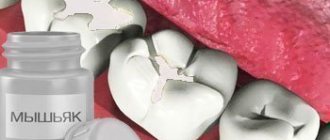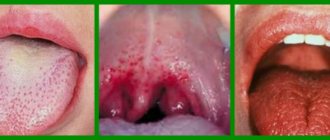It happens that some people who do not experience any health problems in general suddenly feel as if there is a hair in their mouth.
Desperate attempts to remove it do not lead to success, but only cause additional discomfort.
Of course, the reason may also be that hair actually gets into the mucous membrane.
But the feeling can also be illusory , which indicates pathologies in the body .
Causes
The exact causes of the pathology are not fully understood. The disease is not an independent disease; it appears against the background of other diseases. Most often, this phenomenon occurs in men over 40 years of age, but is sometimes observed in women. This disease is very rare in children.
The pathology is most often observed in people with gastrointestinal dysfunction, ulcers and gastritis. The development of the disease is greatly facilitated by poor oral hygiene, smoking habits and excessive coffee consumption.
The main causes of the development of the disease are considered:
- long-term use of medications, especially antibiotics;
- fungal infections;
- dehydration;
- chemotherapy;
- metabolic disease;
- weakened immune system;
- Regular rinsing of the mouth with solutions containing astringents.
The risk group also includes people with dental defects and the absence of a large number of teeth, since in this case they are forced to eat only soft food, which does not have the proper abrasive effect on the surface of the tongue.
Factors contributing to the development of a hairy tongue
Now let's try to figure out why and when filiform papillae grow.
This condition was first described back in 1835. But to this day, its etiology has not been clarified, and scientists do not have a common point of view on the causes of this disease. But a number of factors can be identified that provoke its development:
- trophic. Metabolic disorders in the epithelium of the filiform papillae, for example, this happens with a deficiency of riboflavin (vitamin B2);
- infectious. It has been noticed that often a black hairy tongue appears after a person has suffered a bacterial or viral infection. In patients, at the same time, immunity decreases, which leads to the activation of harmful microflora. Bacteria accumulate on the tongue, together with the keratinizing epithelium, becoming a constant irritant. Thus, the keratinization process is blocked, and hyperplasia of the filiform papillae develops;
- physical and chemical: smoking, alcohol, drugs, poor hygiene, excessive consumption of strong coffee and tea.
During histological examination, a dense stratum corneum can be seen on the hypertrophied filiform papillae; it resembles a rod, with symmetrically extending protrusions that look like a bird’s feather. The keratinization is blocked. The papillae become colored under the influence of food and bacterial pigments, as well as chromogenic fungi.
Symptoms
Pathology is immediately detected during a visual examination by a dentist. In the initial stages of the disease, the presence of a foreign object in the mouth is felt, other unpleasant signs gradually appear, then the upper part of the tongue noticeably turns black. In advanced cases, the affected area occupies two-thirds of the tongue. The disease is accompanied by unpleasant odor from the mouth, changes in taste sensations, a metallic taste appears in the mouth, a feeling of tickling and soreness on the surface of the tongue, as well as causeless nausea. In rare cases, there is a burning sensation and severe itching.
Clinical picture of black hairy tongue
Patients with a black hairy tongue complain of:
- foreign body sensation;
- increased gag reflex, due to the increased mass of filiform papillae at the root of the tongue;
- decreased taste sensitivity;
- halitosis (bad breath);
- burning sensation in the tongue due to the addition of candidal infection.
Hypertrophied filiform papillae are located in the middle and posterior thirds of the dorsum of the tongue. In this case, the affected area is round, oval or triangular. The length of the enlarged papillae can reach two to three centimeters, and the diameter can reach two millimeters. At the base, the filiform papillae are wider, more dense upon palpation, and colored in various shades of brown: from light to almost black. The tip and lateral surfaces of the surface of the tongue, however, are not changed. Regional lymph nodes are not enlarged. In patients with black hairy tongue, the general condition does not suffer.
The diagnosis of black hairy tongue is made on the basis of complaints, the development of the disease and objective data. On examination, an area of pigmented, hyperplastic filiform papillae is observed on the tongue. At the base their color is less intense than at the periphery. When the doctor runs the instrument along the tongue from root to tip, the papillae are raised. The hygiene index in patients with black hairy tongue is unsatisfactory. Upon examination, it is discovered: multiple caries and extensive dental plaque.
In smears taken from the affected area, yeast-like fungi with budding cells are often found, as well as normal microflora of the oral cavity.
Differential diagnosis of black hairy tongue is carried out with Addison's disease, as well as with leukoplakia (hairy form). In some cases, to exclude concomitant pathology, consultations with a therapist and gastroenterologist are necessary.
Treatment
It is necessary to contact a dentist or maxillofacial surgeon with such a problem. To obtain a complete clinical picture, it is necessary to undergo examination by a gastroenterologist, infectious disease specialist, endocrinologist and neurologist. Since the pathology develops against the background of other diseases, a comprehensive treatment regimen is used.
Only treatment of concomitant diseases, professional cleaning and treatment of the oral cavity, taking multivitamin complexes, antifungal medications and, if necessary, sedatives will help eliminate this unpleasant defect. Removal of heavily overgrown papillae can be carried out by cryodestruction (exposure to the pathological focus with liquid nitrogen). It is also necessary to adjust your diet, enriching it with foods with fiber, vitamins and minerals.
The prognosis for black hairy tongue is usually favorable. Elimination of causative factors, as well as appropriate comprehensive treatment of the disease, leads to complete restoration of the surface of the tongue.
Prevention
As such, there is no prevention of black villous tongue. Even with good oral hygiene, you can encounter a similar phenomenon, but with timely treatment of diseases that lead to the development of such a complication, you can minimize the likelihood of the disease occurring.
The following rules must also be observed:
- thoroughly brush your teeth, gums and tongue with a soft brush;
- It is necessary to drink enough water, because if there is a lack of hydration in the oral cavity, it begins to develop; bacteria;
- reduce coffee consumption and quit smoking and alcoholic beverages.
The disease recurs quite rarely. During an exacerbation, the patient is advised to follow a gentle diet; food should be warm and soft in consistency.
Endocrine diseases. Self-diagnosis
Murzaeva Irina Yurievna
Endocrinologist, Preventive Medicine Doctor
September 3, 2017
Unfortunately, the practice of annual medical examinations and mass disease prevention in kindergartens and schools are gradually becoming a thing of the past. Remember, they used to give fish oil, iodine preparations - Antisturmin, etc. for breakfast. Health magazine taught people all over the country to self-diagnose breast tumors, provide first aid to themselves and others... Times change, not always for the better, but this is a separate topic. The motto of “our intertime” is help yourself.
Today I will tell you how to suspect one or another endocrine disease when examining your own body . Just suspect and consult a doctor, and not start treating yourself!
Information about this mysterious photo is below. 
So let's start with SKIN .
It occupies a huge surface area of the body, performs many functions and is the first to respond to changes in the body.
Dryness, peeling (scales) of the skin of the face, torso, arms and legs
- often this is a sign of hypothyroidism (reduced thyroid function), and this is most clearly visible in the dryness and flaking of the elbows, sometimes as a “flour” type, dry elbow with a white coating;
- It can also be a sign of severe dehydration. Take a closer look to see if you have any new wrinkles;
- allergies can always be distinguished - peeling with bright pinpoint rashes and itching;
- peeling and cracking of the fingers - often this is a manifestation of anemia or liver pathology (fatty hepatosis and other diseases);
- But if your feet are dry and flaky, get checked for fungal diseases and diabetes.
What a seemingly insignificant symptom, but so much information.
Acantosis nigricans - I can only write here in Latin, the symptom is extremely important, this is the appearance of dark-colored foci of pigmentation (similar to a tan) in places where clothing rubs: neck, armpits, groin area, under the breasts, on the elbows, a sign of incipient diabetes, or prediabetes. This symptom is also called a sign of insulin resistance (the body’s metabolism of the hormone insulin, which is responsible for the absorption of sugar from food, is disrupted). The symptom is terrible, it also happens in children, and is often a sign of hereditary insulin resistance.
You need to go to an endocrinologist as soon as possible!
Pigmentation is a very broad concept; spots come in different colors and sizes.
A bronze tint of the skin over the entire surface of the body, especially increasing in winter, is a sign of another formidable disease - adrenal insufficiency. It is urgent to donate cortisol and ACTH blood.
Pigmentation with uneven edges, a light brown tint, that appears after childbirth - chloasma, this is a manifestation of a violation of skin nutrition. It is possible that you had iron deficiency anemia during pregnancy; you need to check again to see if there is an iron deficiency. If there are disturbances in the body’s oxidative-antioxidant system (primitively, “a lot of harmful radicals” have accumulated in the body and they damage the skin), it is necessary to resolve the issue of taking alpha-lipoic acid and check liver function.
Pigmentation in women 55+, 60+ is finely dotted, bright brown, which everyone perceives as a tan - a sign of skin aging and a deficiency of sex hormones. It also doesn’t hurt to check for anemia.
Bright brown pigmentation of the lower eyelid can also be a sign of anemia, or, less commonly, adrenal dysfunction.
Pigmentation expressed only on the anterior surface of the skin of the legs (without itching) is often a sign of a “hidden increase” in blood sugar - you need to look for diabetes.
The appearance of bright red spots on the body, often small 2-3 mm - “ruby spots”, a sign of liver dysfunction (fatty hepatosis and other diseases).
Pappules, not acne, on the eyelids, face - they are called xanthomas, these are small wen, it is clear that this is a disorder of fat metabolism and the lipid profile must be checked. They happen even in 7-8 year old children - no one has abolished hereditary dyslipidemia and the child may have cholesterol of 8.0 mmol/l.
INCREASED SWEATING (HYPERHIDROSIS) is a very common symptom.
If the sweating is local - only the hands or only the legs, or only the armpits, this is unlikely to be an endocrine pathology - it is often a dysfunction of the sympathetic nervous system. But sweating all over the body can be a symptom of diffuse toxic goiter, and increased sweating of the scalp is a symptom of vitamin D hypovitaminosis (like rickets).
HAIR
Thinning and hair loss are often the first sign of anemia! This may also be a symptom of hypothyroidism, calcium metabolism disorders and disturbances of other microelements important for hair condition: zinc, selenium, manganese and copper. Hair loss can be a sign of progesterone deficiency (due to cycle disruption in women). And even a decrease in progesterone in men can result in hair loss.
Early gray hair is often the first sign... ANEMIA, sometimes copper deficiency.
Thinning and hair loss at the age of 50+, 60+ is often a deficiency of sex hormones, rather than their excess (previously, in women, this symptom was associated with excess androgens).
But male pattern hair loss in young women, this is hereditary androgenetic alopecia, is often the first symptom of the onset of PCOS (polycystic ovary syndrome).
In men with androgenetic alopecia, everything is simpler - it is often a deficiency of testosterone, and not its excess, as previously thought.
Hair loss in children! – this should be a paradox (a growing child should not have alopecia). This is either a sign of rickets (after 1 year of life, rickets is called osteomalacia), or anemia, or, most often, it is insulin resistance! It is extremely rare, but it happens that it is associated with an autoimmune disease.
Patchy hair loss is a sign of extreme stress, both in children and adults!
In teenage girls, hair loss may be associated with ovarian dysfunction and progesterone deficiency.
Loss of the outer third of the eyebrows is often a sign of iodine deficiency (classic) and hypothyroidism.
Sometimes patients complain about changes in the hair structure, “they were curly and began to straighten sharply” - these are not miracles, this is a violation of the exchange of sex hormones, especially if the woman has been taking COCs (contraceptives) for a long time. In this case, her pituitary gland and ovaries fell asleep, and a deficiency of estrogen and progesterone developed.
And now the most interesting thing is - we take an ordinary centimeter in our hands and begin to measure, what?
- Waist circumference Ladies, a waist circumference of more than 80 cm is incipient obesity. For men – more than 92 cm, “hello obesity.” Children have individual tables for their waist circumference according to height and age; I will not give them here. For the same purpose, pinch yourself under the shoulder blade :D:) If the skin-fat fold in this area is more than 2 cm! This is a sure step towards obesity! When visiting a doctor, it is better to measure the skin-fat fold with a calipermeter; this is a more accurate measurement method.
- Wrist circumference Who said you have a “big bone”? Ladies, wrist circumference: 16-17 cm is the norm. “Thin bone” is less than 16 cm, “large” is more than 17 cm. In men, the norm is 16-20 cm, respectively. But in men it is better not to measure the circumference of the wrist; it is better to determine body composition using bioimpedanceometry - many men have a well-developed or inflated muscle group and it is necessary to look at the real proportions of muscle/fat tissue.
- You can measure the proportion, the ratio of waist circumference / hip circumference. WC/BV more than 0.85 in women and more than 1.0 in men is visceral obesity - obesity of internal organs, indicates the risk of developing metabolic syndrome (obesity with metabolic disorders of both fats and carbohydrates).
You can put the centimeter aside for now;)
LOOKING IN THE MIRROR
Strengthening of nasolabial folds and the appearance of wrinkles outstripping the rate of age-related changes is a sign of a deficiency of sex hormones; it would be good to check with a gynecologist-endocrinologist.
Drooping, swollen upper eyelid - monitor your blood pressure and check your kidneys. In more rare cases, this is a manifestation of hypothyroidism. Swelling and at the same time a change in the shape of the eyes (a look of extreme surprise) is a symptom of dysfunction of the thyroid gland (diffuse - toxic goiter).
Sagging of the oval of the face and the appearance of a double chin are a manifestation of a deficiency of sex hormones and the beginning of a decrease in growth hormone.
NAILS
Ribbed nails, thin and brittle - again everything is primitive, we check for anemia and calcium metabolism disorders. But the flattening and whitening of the nail plates - we check the heart muscle.
So, if all the deficiencies in the body have been eliminated :), but the nails are still thin, the skin is dry and the hair is thinning - it’s time to check the Omega-3 index in the blood, yes, it is the deficiency of healthy omega-3 fats in the body that can be the cause of ongoing skin problems , nails and hair.
The dose of Omega-3 taken will be different for everyone, minimum 2000 mg per day and higher! It is necessary to monitor the omega-3 blood index. That’s why I published this stunning photo of an Eskimo woman at the beginning of the article - gorgeous skin and facial proportions, which means there are no problems with omega-3 and sex hormones:
Finally…..
I really want to talk about the famous “bones” on women’s legs
“they say, I walked around in heels all my youth”;). A woman should walk in heels all her life, and “bunions at the base of the big toe” are a sign of a severe violation of vitamin D metabolism! And, accordingly, weakness of the foot muscles (sarcopenia), so “the bones spread in different directions”, there are no growths there! Get tested for vitamin D deficiency and treat hypovitaminosis D as soon as possible and in large doses.
To be continued…….











